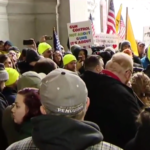The decision is U.S. v. Torres (handed down yesterday). The court doesn’t decide whether “the people” in the Second Amendment includes illegal aliens, but does conclude that illegal aliens are at least outside “the core” of the Second Amendment right:
“[D.C. v. Heller] tells us that the core of the Second Amendment is ‘the right of law-abiding, responsible citizens to use arms in defense of hearth and home.'” … [Title 18] § 922(g)(5) does not burden this core right, because the prohibition applies only to those who are present in the United States “illegally or unlawfully.”
Because of this, the court evaluated the ban on gun possession by illegal aliens under only “intermediate scrutiny,” rather than “strict scrutiny.” In practice, intermediate scrutiny has sometimes been read as quite demanding of the government (almost as demanding as strict scrutiny), for instance as to sex discrimination or commercial speech restrictions. But in other areas, it has often ended up being much less demanding, for instance as to restrictions that incidentally burden symbolic expression, as to content-neutral speech restrictions (at least in many cases), and as to restrictions on gun possession. And here, the Ninth Circuit concluded that the law satisfied this standard, chiefly because it saw gun ownership by illegal aliens as particularly dangerous:
“[T]hose who show a willingness to defy our law are … a group that ought not be armed when authorities seek them.” If armed, unlawful aliens could pose a threat to immigration officers or other law enforcement who attempt to apprehend and remove them.
Further, “[unlawful aliens] often live ‘largely outside the formal system of registration, employment, and identification, [and] are harder to trace and more likely to assume a false identity.'” Therefore, “the ban on the possession of firearms by [unlawful aliens] is substantially related to the statute’s general objectives because such persons are able purposefully to evade detection by law enforcement.”
by Eugene Volokh



